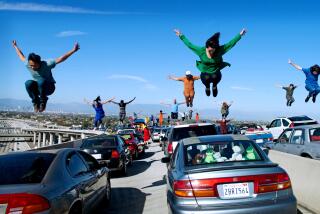Racing stagecoaches hit âthe homestretchâ in Little Tokyo
There is almost nothing to suggest the wild, frontier past of Onizuka Street in Little Tokyo.
Nothing to suggest that it once was traversed by racing stagecoaches in the 1850s, âwith passengers and drivers yelling, and wheels often locked hub to hub to bring up a cloud of dust,â as recounted in the history book âNuestro Pueblo.â
Onizuka, formerly named Weller Street, is now a sedate one-block stretch of road, renamed for Ellison Onizuka, the astronaut who was killed in the 1986 Challenger explosion.
About the only clue to Onizuka Streetâs colorful role in L.A.âs early history is its unusual configuration -- it runs diagonally from the corner of 2nd and San Pedro streets to 1st Street.
Thatâs because Onizuka Street, as âNuestro Puebloâ put it, was âthe homestretchâ of the 21-mile stagecoach route from San Pedro to downtown L.A., a shortcut carved out by rival drivers whose passengers frequently wagered on who would arrive first.
The approach to L.A. was by San Pedro Street, âwhich was a narrow lane, possibly not more than ten feet wide, with growing vineyards bordered by willow trees on each side of the road,â wrote Harris Newmark in his memoir, âSixty Years in California.â
Hence the necessity of veering off onto what became Weller Street, on the way to 1st Street.
The destination of the mule-drawn prairie schooners was the Bella Union Hotel (later the St. Charles) on Main Street, just above Temple Street. The stagecoach fare was about $5.
One of the lines was owned by Phineas Banning, one of the founders of Wilmington who would sometimes take the reins himself in that no-nonsense era.
Winning the stagecoach race was âthe best of advertisingâ for a company and assured âthe largest patronage,â Newmark noted.
âSo . . . from the moment of leaving San Pedro until the final arrival in Los Angeles, two and a half hours later, we tore along at breakneck speed.â
The roads ânever having been cared for, and still less inspected, were abominably bad, and I have often wondered that there were not more accidents.â
Before departure from San Pedro, it was a good time to take something to calm the nerves.
Before leaving on his first trip, author Horace Bell recalled in âReminiscences of a Ranger,â a stagecoach hand brandished âan ominous looking black bottle, remarking, âGentlemen, there is no water between here and Los Angeles.â â
The way he said âwaterâ left no doubt that it held something stronger.
After the male passengers had taken gulps, the driver himself took a swig as he raised âhis eyes heavenward and gazed piously at the stars.â It was not the last swig he would take.
Along the route to downtown, the German-born Newmark remembered, âwe passed thousands of ground squirrels and, never having seen anything of the kind before, I took them for ordinary rats. . . . When later we drove by a number of ranch houses and I saw beef cut into strings and hung up over fences to dry, it seemed as though I had landed on another planet.â It was beef jerky.
An unofficial reception party awaited the passengers as they approached the City of Angels.
On San Pedro Street, Bell recollected, the stagecoach was âfollowed by a pack of dogs barking, yelping and snarling at us in a savage way. With the whole pack at our heels, we drove up to the Bella Union.â Alas for Bell, on that first ride, his carriage was âa half-block in the rear of the winning party.â He lost $50, having bet on the wrong mules.
On another occasion, some stagecoach passengers heading the other way, from downtown L.A. to the harbor, were disappointed for a different reason, historian Boyle Workman recounted in âThe City That Grew.â
It seemed that one of the townâs desperadoes was scheduled to be hanged near City Hall, but the visitors would be leaving before the spectacle occurred. They protested to the shipping company to delay the voyage so they could watch the hanging, but to no avail. But a newspaper, the Southern Californian, saw a way to take advantage of the situation.
The paper âwent to press long before the hanging,â Workman wrote. The execution âwas described in colorful detail, the papers rushed down to the boat and all sold out, while the editor and reporters prayed that the hanging would go off without delay.â Luckily -- at least for the newspaper -- the execution was carried out.
The era of the L.A.-San Pedro stagecoach races would end a few decades later when Banning built a railroad between the two stops. Ironically, he would die in San Francisco in 1885, at the age of 55, after being run over by an express wagon.
As for the former Weller Street, it is quiet these days. Part of the road has been given over to foot traffic for a mall. Barricades at its southern end block the entrance to vehicular traffic. Itâs only a shortcut for pedestrians.
Still, one imagines that the old stagecoach drivers would muster a smile, and perhaps take a celebratory swig from their black bottles, if they could gaze out at the now-paved street. They had left their mark.
--
More to Read
Sign up for Essential California
The most important California stories and recommendations in your inbox every morning.
You may occasionally receive promotional content from the Los Angeles Times.










